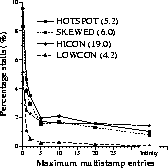
Figure 4: Percentage of fetch stalls as the maximum multistamp size is increased
Figure 4 shows results of experiments as the maximum size for multistamps increases from zero entries (just the threshold timestamp) to the size reached when just aging is used. (A system that uses just the threshold timestamp is using Lamport clocks [18].) The X axis represents increasing multistamp size; the Y axis shows the stall rate. The number in parenthesis after the workload name gives the number of fetches per transaction. The results show that even for small multistamps, the percentage of stalls is low. Low stalls translate into extremely low cost as discussed in Section 6.2.2. Furthermore, we can decrease stall rates by a factor of two, as shown in Section 6.4.

Figure 4: Percentage of fetch stalls as
the maximum multistamp size is increased
LOWCON has relatively few misses (all due to the shared region) and few stalls. Since contention is low on the shared region, the stall rate is extremely low. Most misses in SKEWED and HOTSPOT are due to accesses to the RDB region; HOTSPOT also has coherency misses due to the small region. The stall rate in HOTSPOT is higher than in SKEWED because there is more contention on the small region. Furthermore, since the client can cache a higher percentage of this region than the RDB region in SKEWED, more invalidation entries are generated in HOTSPOT. As a result, there is more truncation, which leads to a higher stall rate.
HICON has very high contention and a high number of stalls. However, the number of fetches is also high because there is a large number of coherency misses in the hot region and capacity misses in the cold region and therefore the stall rates are low. If we had a large enough cache that there were no capacity misses in HICON, the stall rate would be about 2.6% (it will be lower than this since some of the capacity misses will be replaced by coherency misses).
Figure 5 shows multistamp size when only aging is used. These multistamps are large and therefore pruning is needed. As shown in Figure 4, pruning to a reasonable size does not increase stall rate significantly.

Figure 5: No. of multistamp entries with aging